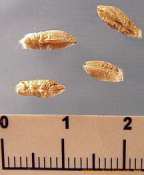Previous Page | Right click this page to print.
Triticale
Triticale grain is a hybrid cross of wheat and rye grains. The objective of triticale was to produce a hardy, high productive grain, with high protein content and a good amino acid profile. The objectives have not been achieved. Generally, in the U.S., triticale is not grown as a feed grain.
Figure 4.22 illustrates triticale grain.

Table 4.8 summarizes the average nutrient composition of triticale.
Nutrient |
Average
Composition, % |
|---|---|
Crude protein |
14.0 |
Ether extract |
4.6 |
Crude fiber |
4.0 |
Ash |
2.0 |
NFE |
75.4 |
Starch |
The nutrient content of triticale is similar to both wheat and rye. Triticale does have a higher fiber content compared to wheat and rye. As a protein source, triticale has a high protein content and a moderate amino acid profile. The nutrient composition of triticale indicates a relatively positive energy and protein value, however, similar to rye the production results of triticale have been lower than expected.
Similar to rye, there are a number of factors that may contribute to the unsatisfactory production results. Triticale is a relatively unpalatable feedstuff. Triticale also contains trypsin and chymotrypsin inhibitors that are detrimental to protein digestion in the animal. The inhibitors are the most influential in triticale. Triticale is also susceptible to ergot infection. Triticale is not as susceptible as rye, but more susceptible than wheat to ergot infection. Triticale also contains alkyl resorcinols and pentosans.
For some nonruminants, the feeding value of triticale is similar to the feeding value of wheat. For cattle, the feeding value may be lower than wheat.
Previous Page | Right click this page to print.